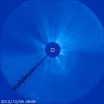(Press-News.org) Chronic morphine exposure has the opposite effect on the brain compared to cocaine in mice, providing new insight into the basis of opiate addiction, according to Mount Sinai School of Medicine researchers. They found that a protein called brain-derived neurotrophic factor (BDNF), which is increased in cocaine addiction, is inhibited in opioid addiction. The research is published in the October 5 issue of Science.
"Our study shows that BDNF responds completely differently with opioid administration compared to cocaine," said Ja Wook Koo, PhD, Postdoctoral Fellow in the Department of Neuroscience at Mount Sinai School of Medicine. "Morphine creates reward by inhibiting BDNF, whereas cocaine acts by enhancing BDNF activity."
BDNF is key to several functions in the brain and peripheral nervous system, notably for making new nerve cells and helping the survival of existing ones. It is also known to activate reward centers in the brain. Cocaine causes an increase in the presence of BDNF in a reward center of the brain called the nucleus accumbens, which results in activation of the reward center.
In the current study, the research team found that morphine suppresses BDNF in a different reward center of the brain known as the ventral tegmental area (VTA), in order to achieve reward and chronic addiction. The morphine caused a depletion of BDNF in the VTA of mice, which activated the reward centers. However, when BDNF was administered to the VTA of mice, it inhibited that reward. When BDNF was administered to the nucleus accumbens, there was no reward.
When researchers analyzed morphine-induced changes in gene expression in the nucleus accumbens, the area of the brain in which morphine caused no reward or response they found that two genes, sox11 and gadd45g, mediated the brain's response to morphine, preventing any reward and addiction.
"This study provides important insight into the molecular basis for morphine addiction, and is the first to show that BDNF is a negative modulator in brain, especially in opioid addiction, unlike stimulant addiction," said Dr. Koo. "While further research is needed, the genes we identified may be useful targets in preventing addiction." Continuing to study the counteractive response of BDNF in morphine as compared to cocaine may also help researchers determine how poly-drug use may impact the brain.
Dr. Koo is part of the Eric Nestler, MD,PhD laboratory at Mount Sinai School of Medicine. Dr. Nestler is the Nash Family Professor and Chair of Neuroscience and Director of the Friedman Brain Institute at Mount Sinai. Students in the Mount Sinai Graduate School of Biological Sciences also participated in the research, including Haosheng Sun and Diane Damez-Werno.
INFORMATION:
This study was supported by grants from the National Institute on Drug Abuse and a Rubicon Grant from the Dutch Scientific Organization.
About The Mount Sinai Medical Center
The Mount Sinai Medical Center encompasses both The Mount Sinai Hospital and Mount Sinai School of Medicine. Established in 1968, Mount Sinai School of Medicine is one of the leading medical schools in the United States. The Medical School is noted for innovation in education, biomedical research, clinical care delivery, and local and global community service. It has more than 3,400 faculty in 32 departments and 14 research institutes, and ranks among the top 20 medical schools both in National Institutes of Health (NIH) funding and by US News and World Report.
The Mount Sinai Hospital, founded in 1852, is a 1,171-bed tertiary- and quaternary-care teaching facility and one of the nation's oldest, largest and most-respected voluntary hospitals. In 2011, US News and World Report ranked The Mount Sinai Hospital 14th on its elite Honor Roll of the nation's top hospitals based on reputation, safety, and other patient-care factors. Mount Sinai is one of 12 integrated academic medical centers whose medical school ranks among the top 20 in NIH funding and US News and World Report and whose hospital is on the US News and World Report Honor Roll. Nearly 60,000 people were treated at Mount Sinai as inpatients last year, and approximately 560,000 outpatient visits took place.
For more information, visit http://www.mountsinai.org/.
Find Mount Sinai on:
Facebook: http://www.facebook.com/mountsinainyc
Twitter: @mountsinainyc
YouTube: http://www.youtube.com/mountsinainy
END
This press release is available in French.
Methadone reduces the risk of HIV transmission in people who inject drugs (PWID), as reported by an international team of researchers in a paper published today in the online edition of the British Medical Journal. This team included Dr. Julie Bruneau from the CHUM Research Centre (CRCHUM) and the Department of Family Medicine at the Université de Montréal.
"There is good evidence to suggest that opiate substitution therapies (OST) reduce drug-related mortality, morbidity and some of the injection risk behaviors among PWID. ...
WASHINGTON -- NASA's Swift satellite recently detected a rising tide of high-energy X-rays from a source toward the center of our Milky Way galaxy. The outburst, produced by a rare X-ray nova, announced the presence of a previously unknown stellar-mass black hole.
"Bright X-ray novae are so rare that they're essentially once-a-mission events and this is the first one Swift has seen," said Neil Gehrels, the mission's principal investigator, at NASA's Goddard Space Flight Center in Greenbelt, Md. "This is really something we've been waiting for."
An X-ray nova is a short-lived ...
At 11:24 p.m. EDT on Oct. 4, 2012, the sun unleashed a coronal mass ejection (CME). Not to be confused with a solar flare, which is a burst of light and radiation, CMEs are a phenomenon that can send solar particles into space and can reach Earth one to three days later. Experimental NASA research models show the CME to be traveling at about 400 miles per second.
When Earth-directed, CMEs can affect electronic systems in satellites and on Earth. CMEs of this speed, however, have not generally caused major effects in the past. Further updates will be provided if needed.INFORMATION:
NOAA's ...
NASA's Hurricane and Severe Storm Sentinel or HS3 scientists had a fascinating tropical cyclone to study in long-lived Hurricane Nadine. NASA's Global Hawk aircraft has investigated Nadine five times during the storm's lifetime.
NASA's Global Hawk also circled around the eastern side of Hurricane Leslie when it initially flew from NASA's Dryden Research Flight Center, Edwards Air Force Base, Calif. to the HS3 base at NASA's Wallops Flight Facility, Wallops Island, Va. on Sept. 6-7, 2012.
Nadine has been a great tropical cyclone to study because it has lived so long ...
From Sept. 6 to Sept. 29, 2012, NASA's Solar Dynamic Observatory (SDO) moved into its semi-annual eclipse season, a time when Earth blocks the telescope's view of the sun for a period of time each day. Scientists choose orbits for solar telescopes to minimize eclipses as much as possible, but they are a fact of life -– one that comes with a period of fuzzy imagery directly after the eclipse.
The Helioseismic and Magnetic Imager (HMI) on SDO observes the sun through a glass window. The window can change shape in response to temperature changes, and does so dramatically ...
It is easy to see the effect of the strong northeasterly wind shear battering Tropical Storm Gaemi in satellite imagery from NASA. Visible imagery on Oct. 5 shows a large oval-shaped area of showers and thunderstorms associated with the storm, southwest of the exposed center of circulation.
NASA's Aqua satellite passed over Tropical Storm Gaemi as it was approaching Vietnam on Oct. 5, 2012 at 0550 UTC (1:50 a.m. EDT). A true-color image of the storm was captured by the Moderate Resolution Imaging Spectroradiometer (MODIS) instrument and shows bulk of showers and thunderstorms ...
(Boston) – Boston University School of Medicine (BUSM) investigators have led the first genome-wide evaluation of genetic variants associated with Parkinson's disease (PD). The study, which is published online in PLOS ONE, points to the involvement of specific genes and alterations in their expression as influencing the risk for developing PD.
Jeanne Latourelle, DSc, assistant professor of neurology at BUSM, served as the study's lead author and Richard H. Myers, PhD, professor of neurology at BUSM, served as the study's principal investigator and senior author.
A ...
With the rapid development of industrialization and urbanization in China, the demand for electricity continues to grow, according to a report by State Grid Corporation of China. Exploring and utilizing renewable energy, enhancing energy efficiency are significant to the energy supply, energy structure adjustment and energy-saving in China. Being the No. 1 Electric Power Expo in China, The 14th International Exhibition on Electric Power Equipment and Technology, The 7th International Exhibition on Electrical Equipment and 2012 International Exhibition on Electric Power ...
Puja Sapra, Director, Oncology Research Unit at Pfizer Will Give a Featured Presentation on "Design Considerations For Development of an Optimal Antibody-Drug Conjugate" at the 5th ImmunoTherapeutics & ImmunoMonitoring Conference (Jan 31 - Feb 1, 2013 in San Diego)
Antibody-drug conjugates (ADCs) represent a promising therapeutic modality for the clinical management of cancer. Dr. Puja Sapra will use case studies to elaborate on the multifaceted optimization required to yield a viable clinical candidate ADC. ADCs employing different mechanism of action ...
Powered by a team with years of experience in marketing, technology, and design, bMighty2 is a new digital marketing agency that promises to help small businesses find success online.
The start-up will help small businesses leverage the Internet and Web 2.0 for their marketing needs using a multi-channel approach. Services to be offered by bMighty2 include website development, local search engine optimization, email marketing, social media marketing, and directory link building.
"bMighty2 was built from the ground up to help small businesses understand and ...




